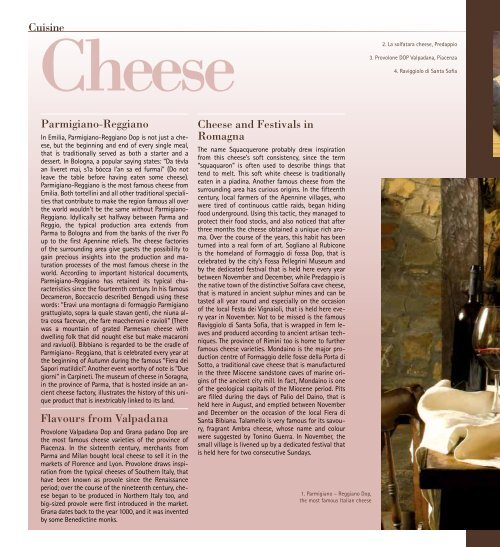of Emilia Romagna
of Emilia Romagna
of Emilia Romagna
Create successful ePaper yourself
Turn your PDF publications into a flip-book with our unique Google optimized e-Paper software.
Cuisine<br />
Cheese<br />
2. La solfatara cheese, Predappio<br />
3. Provolone DOP Valpadana, Piacenza<br />
4. Raviggiolo di Santa S<strong>of</strong>ia<br />
Parmigiano-Reggiano<br />
In <strong>Emilia</strong>, Parmigiano-Reggiano Dop is not just a cheese,<br />
but the beginning and end <strong>of</strong> every single meal,<br />
that is traditionally served as both a starter and a<br />
dessert. In Bologna, a popular saying states: “Da tèvla<br />
an liveret mai, s’la bòcca l’an sa ed furmai” (Do not<br />
leave the table before having eaten some cheese).<br />
Parmigiano-Reggiano is the most famous cheese from<br />
<strong>Emilia</strong>. Both tortellini and all other traditional specialities<br />
that contribute to make the region famous all over<br />
the world wouldn’t be the same without Parmigiano-<br />
Reggiano. Idyllically set halfway between Parma and<br />
Reggio, the typical production area extends from<br />
Parma to Bologna and from the banks <strong>of</strong> the river Po<br />
up to the first Apennine reliefs. The cheese factories<br />
<strong>of</strong> the surrounding area give guests the possibility to<br />
gain precious insights into the production and maturation<br />
processes <strong>of</strong> the most famous cheese in the<br />
world. According to important historical documents,<br />
Parmigiano-Reggiano has retained its typical characteristics<br />
since the fourteenth century. In his famous<br />
Decameron, Boccaccio described Bengodi using these<br />
words: “Eravi una montagna di formaggio Parmigiano<br />
grattugiato, sopra la quale stavan genti, che niuna altra<br />
cosa facevan, che fare maccheroni e ravioli” (There<br />
was a mountain <strong>of</strong> grated Parmesan cheese with<br />
dwelling folk that did nought else but make macaroni<br />
and raviuoli). Bibbiano is regarded to be the cradle <strong>of</strong><br />
Parmigiano- Reggiano, that is celebrated every year at<br />
the beginning <strong>of</strong> Autumn during the famous “Fiera dei<br />
Sapori matildici”. Another event worthy <strong>of</strong> note is “Due<br />
giorni” in Carpineti. The museum <strong>of</strong> cheese in Soragna,<br />
in the province <strong>of</strong> Parma, that is hosted inside an ancient<br />
cheese factory, illustrates the history <strong>of</strong> this unique<br />
product that is inextricably linked to its land.<br />
Flavours from Valpadana<br />
Provolone Valpadana Dop and Grana padano Dop are<br />
the most famous cheese varieties <strong>of</strong> the province <strong>of</strong><br />
Piacenza. In the sixteenth century, merchants from<br />
Parma and Milan bought local cheese to sell it in the<br />
markets <strong>of</strong> Florence and Lyon. Provolone draws inspiration<br />
from the typical cheeses <strong>of</strong> Southern Italy, that<br />
have been known as provole since the Renaissance<br />
period; over the course <strong>of</strong> the nineteenth century, cheese<br />
began to be produced in Northern Italy too, and<br />
big-sized provole were first introduced in the market.<br />
Grana dates back to the year 1000, and it was invented<br />
by some Benedictine monks.<br />
Cheese and Festivals in<br />
<strong>Romagna</strong><br />
The name Squacquerone probably drew inspiration<br />
from this cheese’s s<strong>of</strong>t consistency, since the term<br />
“squaquaron” is <strong>of</strong>ten used to describe things that<br />
tend to melt. This s<strong>of</strong>t white cheese is traditionally<br />
eaten in a piadina. Another famous cheese from the<br />
surrounding area has curious origins. In the fifteenth<br />
century, local farmers <strong>of</strong> the Apennine villages, who<br />
were tired <strong>of</strong> continuous cattle raids, began hiding<br />
food underground. Using this tactic, they managed to<br />
protect their food stocks, and also noticed that after<br />
three months the cheese obtained a unique rich aroma.<br />
Over the course <strong>of</strong> the years, this habit has been<br />
turned into a real form <strong>of</strong> art. Sogliano al Rubicone<br />
is the homeland <strong>of</strong> Formaggio di fossa Dop, that is<br />
celebrated by the city’s Fossa Pellegrini Museum and<br />
by the dedicated festival that is held here every year<br />
between November and December, while Predappio is<br />
the native town <strong>of</strong> the distinctive Solfara cave cheese,<br />
that is matured in ancient sulphur mines and can be<br />
tasted all year round and especially on the occasion<br />
<strong>of</strong> the local Festa dei Vignaioli, that is held here every<br />
year in November. Not to be missed is the famous<br />
Raviggiolo di Santa S<strong>of</strong>ia, that is wrapped in fern leaves<br />
and produced according to ancient artisan techniques.<br />
The province <strong>of</strong> Rimini too is home to further<br />
famous cheese varieties. Mondaino is the major production<br />
centre <strong>of</strong> Formaggio delle fosse della Porta di<br />
Sotto, a traditional cave cheese that is manufactured<br />
in the three Miocene sandstone caves <strong>of</strong> marine origins<br />
<strong>of</strong> the ancient city mill. In fact, Mondaino is one<br />
<strong>of</strong> the geological capitals <strong>of</strong> the Miocene period. Pits<br />
are filled during the days <strong>of</strong> Palio del Daino, that is<br />
held here in August, and emptied between November<br />
and December on the occasion <strong>of</strong> the local Fiera di<br />
Santa Bibiana. Talamello is very famous for its savoury,<br />
fragrant Ambra cheese, whose name and colour<br />
were suggested by Tonino Guerra. In November, the<br />
small village is livened up by a dedicated festival that<br />
is held here for two consecutive Sundays.<br />
1. Parmigiano – Reggiano Dop,<br />
the most famous Italian cheese
















